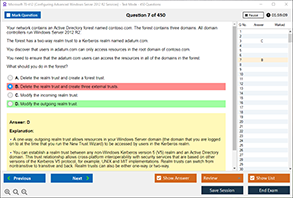Introduction
In today's digital world, seamless network connectivity is essential for efficient communication and data exchange. Every device that connects to a network requires an IP address to communicate with other devices. However, manually assigning IP addresses to each device can be a time-consuming and error-prone process. This is where the Dynamic Host Configuration Protocol (DHCP) comes into play. DHCP is a crucial network protocol that automates the process of assigning IP addresses to devices on a network. This blog, presented by DumpsQueen Official, will explore how DHCP works, its significance, benefits, and security considerations.
Understanding Dynamic Host Configuration Protocol (DHCP)
DHCP is a network protocol that automates the assignment of IP addresses and other network configurations to devices. It ensures that each device receives a unique IP address dynamically, preventing conflicts and simplifying network management. This protocol operates on a client-server model, where a DHCP server manages the allocation of IP addresses, while DHCP clients request and receive configuration settings.
How DHCP Works
When a device connects to a network, it undergoes a process known as DORA, which consists of four key steps:
-
Discovery: The client device sends a broadcast message to locate a DHCP server.
-
Offer: The DHCP server responds with an available IP address and other network settings.
-
Request: The client requests the offered IP address from the DHCP server.
-
Acknowledgment: The server confirms the assignment and provides additional network parameters, such as the subnet mask, default gateway, and DNS server.
This automated process ensures that devices are configured properly without manual intervention, making DHCP an essential component of modern networking.
Importance of DHCP in Networking
The DumpsQueen Official website emphasizes the significance of DHCP in managing large networks efficiently. Without DHCP, network administrators would have to manually assign and manage IP addresses, leading to increased chances of conflicts and misconfigurations. DHCP ensures:
-
Efficient IP Address Management: Prevents duplicate addresses and optimizes the use of available IPs.
-
Simplified Network Administration: Reduces the burden on IT professionals by automating IP assignments.
-
Scalability: Supports growing networks by dynamically assigning addresses to new devices.
-
Seamless Connectivity: Ensures that devices connect to the network without manual configuration.
DHCP vs. Manual IP Assignment
In traditional networking setups, IP addresses were assigned manually, which was feasible for small networks but impractical for larger ones. With DHCP, devices receive IP addresses dynamically, reducing the chances of human error and making network management more efficient. Unlike static IP assignment, which requires administrators to configure each device individually, DHCP enables automatic, conflict-free allocation of addresses.
Components of a DHCP System
A DHCP system consists of several key components that work together to manage IP address assignments:
-
DHCP Server: The central system responsible for allocating IP addresses and network configurations.
-
DHCP Client: The device requesting an IP address from the DHCP server.
-
IP Address Pool: A range of IP addresses that the server assigns dynamically to clients.
-
Lease Duration: The period for which an IP address is assigned to a device before renewal.
-
DHCP Relay Agent: A network component that forwards DHCP requests from clients to servers when they are on different subnets.
These components collectively ensure that devices are assigned unique IP addresses without manual intervention.
Security Considerations in DHCP
While DHCP is a powerful tool, it is not without security risks. One of the main concerns is the possibility of rogue DHCP servers—unauthorized devices that issue incorrect or malicious network configurations. Additionally, DHCP-based attacks, such as IP address spoofing and denial-of-service attacks, can compromise network security. To mitigate these risks, organizations implement security measures such as:
-
DHCP Snooping: A network security feature that filters and blocks untrusted DHCP messages.
-
MAC Address Binding: Ensuring that only authorized devices receive specific IP addresses.
-
Authentication Mechanisms: Verifying DHCP clients before assigning IP configurations.
By implementing these security practices, businesses and network administrators can safeguard their networks against potential threats.
The Role of DHCP in Modern Networks
As networks continue to expand and become more complex, DHCP remains a vital component in ensuring efficient connectivity. From corporate offices to public Wi-Fi networks, DHCP enables seamless device integration, allowing users to connect without manually configuring network settings. DumpsQueen Official highlights the importance of DHCP in:
-
Cloud Networking: Managing dynamic IP assignments in cloud environments.
-
Enterprise Networks: Ensuring smooth operation across multiple devices.
-
IoT and Smart Devices: Automatically configuring IP addresses for connected devices.
The versatility of DHCP makes it an indispensable protocol for modern networking.
Conclusion
The Dynamic Host Configuration Protocol (DHCP) plays a crucial role in automating IP address assignments, reducing administrative overhead, and ensuring seamless network connectivity. By eliminating the need for manual IP configuration, DHCP enhances efficiency, prevents address conflicts, and simplifies network management. However, organizations must implement security measures to protect against potential threats associated with DHCP. As technology continues to evolve, DHCP remains an essential protocol in modern networking, supporting businesses, enterprises, and individuals in maintaining reliable network connectivity.
Free Sample Questions
1. What is the primary function of DHCP?
A. Encrypting network traffic
B. Automatically assigning IP addresses
C. Blocking unauthorized users
D. Monitoring network performance
Answer: B. Automatically assigning IP addresses
2. Which step occurs first in the DHCP process?
A. Offer
B. Discovery
C. Request
D. Acknowledgment
Answer: B. Discovery
3. What is a potential security risk associated with DHCP?
A. Improved network efficiency
B. Rogue DHCP servers
C. Faster data transmission
D. Increased manual configuration
Answer: B. Rogue DHCP servers
4. What component of DHCP is responsible for managing IP address assignments?
A. DHCP Relay Agent
B. DHCP Client
C. DHCP Server
D. IP Address Pool
Answer: C. DHCP Server



